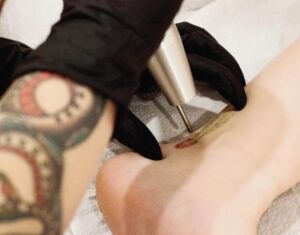Dermabrasion – also known as surgical skin planing – is classified as a skin-resurfacing procedure as it “sands†the outer layers of the skin. Using a rapidly rotating device, a dermatologic surgeon removes the surface and middle layers of the tattoo.
Following the procedure, the new skin generally has a smoother and refreshed appearance. Dermabrasion can be performed in the dermatologic surgeon’s office or in an outpatient surgical facility.
Why choose dermabrasion for tattoo removal
- Possible lower cost.
- True-and-tried method for tattoo removal in many cases.
- It can be done on an outpatient basis.
What to expect after the procedure
Recovery time following dermabrasion is usually two to three weeks. For several days, the skin will likely feel “wind-burned.†The patient will be temporarily left with pink or red skin at the treatment site. The pinkness usually fades within eight to 12 weeks. Patients are asked to avoid the sun for three to six months following the procedure and should apply sunscreen on a regular basis when outside. Exposure to sunlight can lead to excessive scarring.
How to prepare for the procedure
Before the procedure, the doctor will most likely review the patient’s medical history and conduct a physical exam. This is the time for the patient and doctor to discuss expectations, potential risks and outcomes of the procedure.
A patient may be directed to stop taking certain medications including blood thinners and any medications that may trigger hyperpigmentation (skin becoming darker than normal). Just before the procedure, a patient may be given medication to relax, and the treatment area will be sprayed to freeze or numb the skin.
Dermabrasion for Unwanted Tattoos
Estimated cost
The cost for dermabrasion tattoo removal can range from several hundred dollars up to thousands of dollars, depending on several factors:
- The size of the tattoo
- Type of tattoo
- Location on the body
- Age of the tattoo
- Number of office visits required to remove the tattoo
It is difficult to predict how many treatments it will take to get the desired results. Certain pigments have proven to be easier to remove, with fluorescent colors being the most challenging. Because tattoo removal is considered an aesthetic or cosmetic procedure in nature, it generally is not covered by medical insurance.Dermabrasion for Unwanted Tattoos
Possible risks
Dermabrasion may cause various minor side effects, including:
- Redness, swelling or bleeding.
- Changes in skin color – including hyperpigmentation (treated skin becomes darker than normal), hypopigmentation (lighter than normal) or blotchiness.
- Infection – although rare – may occur.
- Dermabrasion that is performed too deeply may cause scarring.

